VMware è la società di software più popolare che fornisce soluzioni di cloud computing e virtualizzazione a livello aziendale. Se sei un professionista della tecnologia, è probabile che tu abbia lavorato o almeno ne conosca il nome. VMware è ampiamente utilizzato per distribuire server e piattaforme cloud sul web. Molti utenti domestici lo usano anche per creare le loro macchine virtuali Linux preferite. Inoltre, offrono un vasto elenco di utilità utili per l'utente, note come strumenti VMware. Questi sono sviluppati appositamente per migliorare le prestazioni delle tue macchine virtuali e rendere la gestione quasi senza sforzo. Questa guida discuterà 30 VMtools estremamente utili che possono rendere la virtualizzazione più accessibile che mai.
I migliori strumenti VMware per i professionisti della tecnologia
Alcuni strumenti VMware aumentano la velocità e le prestazioni delle tue macchine virtuali, mentre alcuni strumenti di gestione VMware renderanno l'amministrazione un gioco da ragazzi. I nostri redattori hanno compilato questo elenco con tutti i tipi di strumenti per aiutare i moderni professionisti della tecnologia. Dai un'occhiata e installa quelli di cui hai veramente bisogno.
1. Rapporto come costruito
La prima scelta nel nostro elenco è un avvincente framework di configurazione utilizzato per produrre documenti di compilazione in diversi formati, inclusi testo, HTML, XML e Word. Utilizza Windows PowerShell e il suo framework di documentazione PScribo. Gli amministratori utilizzano spesso questo robusto strumento per creare report per le loro attività relative all'IT. Inoltre, questo strumento è piuttosto leggero e non consumerà risorse significative delle tue macchine virtuali.
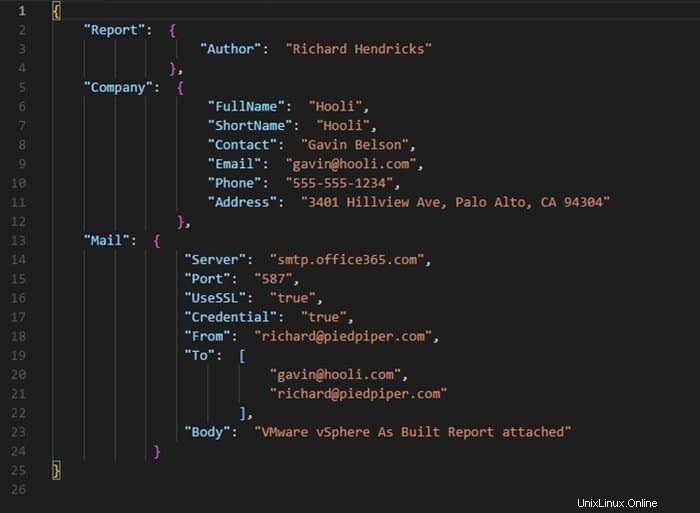
Funzionalità del rapporto As Built
- As Built Report viene fornito con il supporto integrato per diversi modelli di stili personalizzati, tra cui copertina, sommario, colori e caratteri.
- Può essere utilizzato per eseguire controlli di integrità dei problemi di configurazione di VMware e inviare report su Internet.
- L'interfaccia utente è piuttosto semplice e sembra abbastanza legittima se si considera la sua ridotta impronta di memoria.
- Questo strumento di amministrazione VMware è interamente open source e può essere modificato o esteso senza alcun problema legale.
2. ESXTOP
ESXTOP è uno dei migliori strumenti VMware per analizzare i problemi di prestazioni delle tue macchine virtuali. È un solido strumento di gestione delle risorse disponibile negli ambienti di virtualizzazione vSphere ed ESXi. ESXTOP è ampiamente utilizzato dagli amministratori VMware per acquisire l'utilizzo delle risorse rispetto alle metriche delle prestazioni.
Inoltre, le sue efficienti capacità di analisi possono aiutare a ridurre eventuali svantaggi nelle prestazioni. Gli utenti esperti di Linux possono considerarlo un'alternativa VMware a Unix TOP.
Caratteristiche di ESXTOP
- ESXTOP fornisce dettagli sull'ambiente in tempo reale per le tue macchine virtuali, inclusi spazio su disco, CPU, rete e utilizzo della memoria.
- È uno strumento a riga di comando che consente di mantenere un basso footprint di memoria e allo stesso tempo di essere efficiente in termini di prestazioni.
- ESXTOP consente la creazione di connessioni live agli host ESX e supporta la codifica a colori per i contatori pertinenti.
- Fornisce agli utenti un modo pratico per caricare l'output in batch e riprodurli se necessario.
3. Utilità di migrazione dei carichi di lavoro tra vCenter
Se sei un professionista IT responsabile della gestione di più macchine virtuali, Cross vCenter Workload Migration Utility è tra i migliori strumenti di gestione VMware per te. È un'utilità interessante che consente agli amministratori di migrare macchine virtuali tra diversi server vCenter utilizzando un'interfaccia GUI ben strutturata. È uno strumento competente con funzionalità rivolte ai moderni fornitori di servizi di virtualizzazione.

Funzionalità dell'utilità di migrazione dei carichi di lavoro tra vCenter
- L'intero flusso di lavoro basato sull'interfaccia utente di questo strumento VMware semplifica la migrazione simultanea di più macchine virtuali.
- Gli amministratori possono migrare le loro macchine virtuali in parallelo o creare processi di migrazione in batch utilizzando questo strumento.
- Può popolare automaticamente gli inventari per una comoda gestione e supporta le API REST per automatizzare le attività di migrazione.
- L'utility Cross vCenter Workload Migration consente sia la migrazione di storage vMotion che di datastore condiviso per le tue VM.
4. Vmware Git
Git è diventato di fatto il sistema di controllo della versione sia per i progetti open source che per quelli proprietari sin dal suo inizio nel 2005. Rende più facile contribuire ai progetti che ti interessano e può essere un ottimo modo per aumentare la collaborazione di terze parti per il tuo Progetti Vmware.
Sebbene le macchine virtuali VMware non consentano agli utenti di connettersi a Internet per impostazione predefinita a causa delle politiche di sicurezza, gli amministratori di solito possono aggirare questo problema utilizzando una rete con bridge tra la VM e l'host.
Funzionalità di VMware Git
- Gli utenti devono stabilire una connessione di rete con bridge tramite la scheda di rete del computer host per utilizzare Git sul proprio computer VMware.
- Devi avere il client Git installato sia sulla macchina host che sulla macchina virtuale Vmware.
- È necessaria una cartella condivisa dove conserverai o lavorerai con i file dei tuoi progetti.
- È possibile integrare il client Git tramite la funzione di assemblaggio cloud delle tue macchine VMware.
5. Panca HCI
HCI Bench è l'abbreviazione di "Hyper-converged Infrastructure Benchmark", un robusto livello di automazione attorno alle utility Vdbench e Fio open source. È un moderno strumento di amministrazione VMware in grado di confrontare efficacemente le metriche delle prestazioni della tua macchina virtuale.
Se lavori esclusivamente con cluster HCI, questo strumento ti tornerà utile per automatizzare i tuoi test. Nel complesso, HCI Bench è un'ottima soluzione a molti dei tuoi problemi di automazione VMware.
Caratteristiche della panca HCI
- HCI Bench consente agli amministratori di accelerare i test delle prestazioni POC tramite un processo end-to-end completamente automatizzato.
- Questo strumento Vmware può essere utilizzato per avviare macchine virtuali di test, aggregare il risultato del test e risolvere i problemi.
- HCI Bench consente agli amministratori di valutare le prestazioni sia di vSAN che di storage dell'infrastruttura iperconvergente.
- I dati forniti da questo strumento VMware possono essere utilizzati per determinare potenziali colli di bottiglia nelle tue macchine virtuali.
6. Iper
Hyper è, senza dubbio, uno dei migliori strumenti VMware per i fornitori di servizi di virtualizzazione. Offre un'interfaccia a riga di comando elegante ed estensibile creata utilizzando standard Web aperti. Hyper si concentra principalmente su velocità e prestazioni, oltre a stabilità e sicurezza.
Fornisce inoltre un solido elenco di API che rende la comunicazione molto più semplice per gli amministratori delle VM. Hyper è attualmente disponibile per tutte le principali piattaforme di sistema guest, inclusi Linux, Windows e Mac OS.
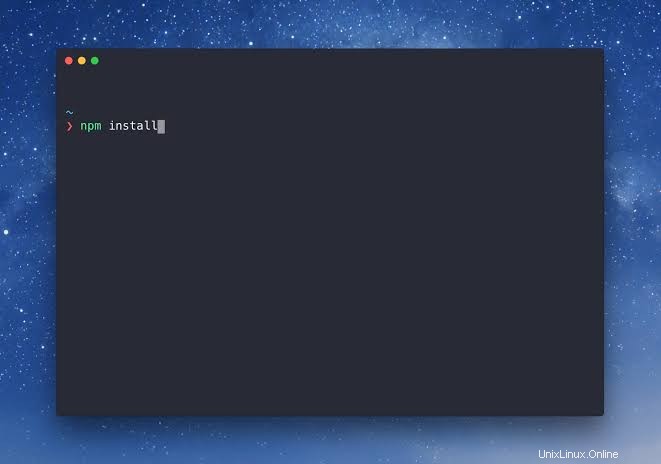
Caratteristiche di Hyper
- Hyper è eccezionalmente configurabile e supporta un'ampia gamma di mappe dei tasti e API di estensione per impostazione predefinita.
- L'interfaccia utente è semplice ma offre una grande quantità di funzioni che migliorano la produttività ed è ben collaudata.
- La natura open source di questo strumento VMware incoraggia gli sviluppatori ad estenderne le funzionalità in base alle loro esigenze.
- Nel gestore di pacchetti npm è già disponibile un gran numero di estensioni predefinite per Hyper.
7. Linux VSM
Linux VSM è una porta Linux intelligente del popolare VMware Software Manager. È una soluzione moderna che offre un'ampia gamma di comode funzionalità che renderanno più semplice la gestione delle macchine virtuali sia per gli utenti domestici che per quelli professionali.
Se sei un amministratore VMware incaricato di gestire macchine virtuali su larga scala per scopi aziendali, questo è uno strumento indispensabile nel tuo arsenale. Nonostante l'enorme potenziale di questo strumento di amministrazione VMware, è completamente gratuito.
Caratteristiche di Linux VSM
- L'approccio intelligente di Linux VSM alla gestione del software assicura che la tua operazione non si interrompa in caso di file mancanti.
- La natura open source di questo Linux VMware Software Manager consente agli sviluppatori di terze parti di aggiungere nuove funzionalità come desiderano.
- VSM per Linux consente agli amministratori di accedere al proprio account VMware, visualizzare download attivi/passati, modificare o modificare i sottoinsiemi di download e molto altro.
- È un software leggero che lo rende particolarmente adatto per macchine virtuali ad alta intensità di risorse.
8. IOInsight
IOInsight è uno dei migliori strumenti VMware per tenere sotto controllo i dispositivi a blocchi. Queste sono le unità rimovibili e altri dispositivi I/O utilizzati dalle macchine virtuali VMware. IOInsight consente agli amministratori di monitorare questi dispositivi con un'interfaccia facile da usare che offre numerose operazioni.
Il software può essere gestito senza sforzo e utilizzato da molti esperti di virtualizzazione professionisti grazie alle sue applicazioni pratiche e alle robuste funzionalità che migliorano le prestazioni.
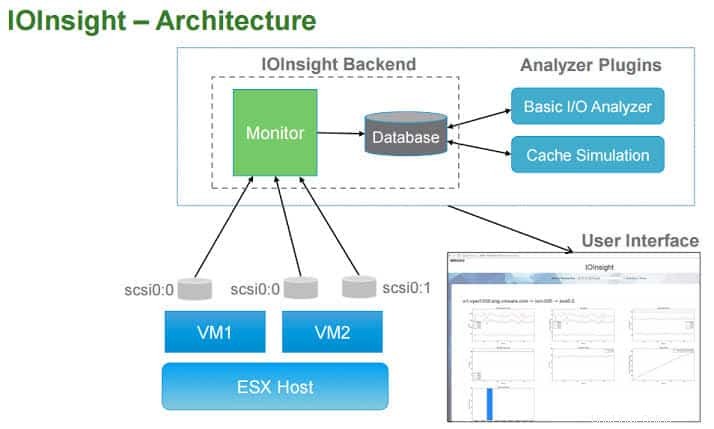
Caratteristiche di IOInsight
- L'interfaccia utente basata sul Web di questo strumento di monitoraggio del disco semplifica il monitoraggio dei problemi dei dispositivi I/O.
- IOInsight consente agli utenti di scegliere quale VMDK (Virtual Machine Disk) desiderano monitorare e risolvere i problemi.
- È utile per ottimizzare le prestazioni complessive delle macchine virtuali identificando e risolvendo i colli di bottiglia dello storage.
- IOInsight viene spesso utilizzato per ottimizzare le dimensioni e le prestazioni dei dispositivi a blocchi dagli amministratori VMware professionisti.
9. vRealize Log Insight
L'esecuzione di controlli regolari dei dati vSphere è essenziale se desideri che i tuoi cluster aziendali continuino a funzionare senza problemi. Lo strumento vRealize Log Insight è stato sviluppato per questo scopo. È un software standard del settore per l'analisi dei registri di sistema ed è molto ben supportato.
Se sei un amministratore VMware professionista che lavora con cluster eterogenei su larga scala, vRealize Log Insight può essere una delle aggiunte più utili nel tuo toolkit. Tuttavia, questo strumento non è gratuito, come la maggior parte degli strumenti menzionati qui.
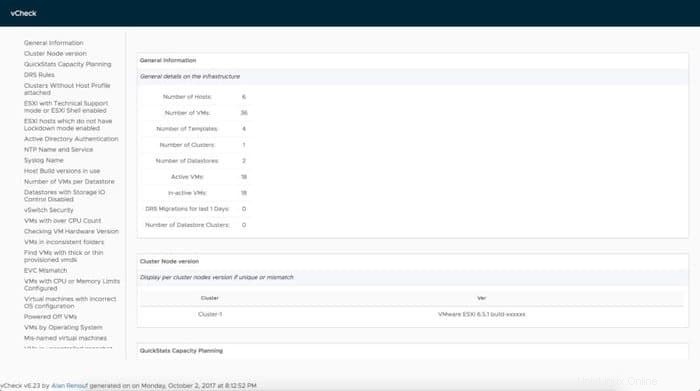
Funzionalità di vRealize Log Insight
- vRealize Log Insight raccoglie tutti i tipi di log (dati delle applicazioni, tracce di rete, configurazioni, dump di sistema) generati dalle tue macchine virtuali.
- Può strutturare automaticamente i dati di log non strutturati per aiutare a creare cluster ad alte prestazioni.
- I moderni ingegneri della virtualizzazione utilizzano spesso questo strumento per monitorare e analizzare i dati di registro in tempo reale.
- Lo strumento vRealize Log Insight è eccezionalmente scalabile e progettato per funzionare con sistemi in continua espansione.
10. mRemoteNG
Poiché la virtualizzazione è l'area più comune delle macchine virtuali Linux, è obbligatorio disporre di un gestore di connessioni remote completo che consenta di gestire più sistemi contemporaneamente. mRemoteNG è uno di questi strumenti che può essere utilizzato per questo scopo.
È una delle soluzioni più semplici ma eleganti che i nostri redattori potrebbero trovare per tali situazioni. Inoltre, le prestazioni altamente efficienti di questo software ci rendono piuttosto difficile non consigliarlo a un collega professionista.
Funzionalità di mRemoteNG
- La natura open source di mRemoteNG assicura che gli sviluppatori possano modificare o estendere la funzionalità di questo gestore di connessione remota in base alle loro esigenze.
- Supporta un vasto elenco di servizi di connessione remota, tra cui Virtual Network Computing (VNC), SSH, rlogin, HTTP[S], telnet e Remote Desktop Servers (RDP).
- mRemoteNG offre supporto immediato per connessioni raw socket e Citrix Independent Computing Architecture.
- Hanno un binario predefinito disponibile solo per i sistemi Windows, quindi dovrai compilarlo dalla fonte.
11. pgAdmin
PostgreSQL è uno dei sistemi di database più utilizzati per lo sviluppo di applicazioni aziendali moderne. Lo strumento pgAdmin è tra quei pochi strumenti VMware dedicati esclusivamente alla gestione di questi database e svolge un ottimo lavoro da parte loro.
Il software è semplice ma offre molte funzionalità, tra cui il supporto multipiattaforma, l'evidenziazione della sintassi e la documentazione preparata con cura. I nostri redattori consigliano vivamente pgAdmin per gli sviluppatori di software aziendali grazie al suo ricco set di funzionalità.
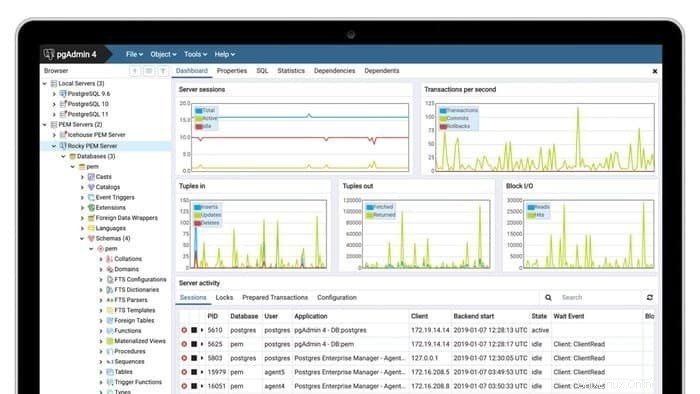
Funzionalità di pgAdmin
- pgAdmin offre un potente strumento di query con funzioni utili come l'evidenziazione della sintassi, l'analizzatore di query e tecniche di ricerca efficaci.
- È completamente gratuito da ottenere o utilizzare e incoraggia gli sviluppatori di terze parti a estendere le funzionalità dello strumento in base alle loro esigenze.
- pgAdmin implementa una versione altamente ottimizzata di Webpack, che ne aumenta notevolmente le prestazioni complessive.
- Consente agli utenti di gestire i server PostgreSQL situati dietro proxy inversi e consente tabelle delle partizioni di backup opzionali.
12. pocli
pocli è un software client vantaggioso ma semplice per ownCloud. È costruito utilizzando il linguaggio di programmazione Python e consente comode operazioni sui file per semplificare la gestione del cloud.
Questo è uno strumento solo da riga di comando e si rivolge agli utenti che non utilizzano affatto la GUI sulle loro macchine virtuali. Se sei un amministratore di sistema virtuale professionista che lavora a lungo con il tuo Cloud o Dropbox, considera pocli una scelta eccellente per te.
Caratteristiche di pocli
- pocli è sviluppato utilizzando le librerie standard di Python e funziona senza problemi su tutti i tipi di hardware di virtualizzazione che supportano Python.
- Consente agli amministratori di caricare e scaricare file oltre alla capacità di gestire le gerarchie di directory in modo efficiente.
- pocli è, senza alcun dubbio, una delle soluzioni software client più leggere sia per gli utenti che per gli amministratori di ownCloud.
- È semplice configurare gli accessi al cloud con i suoi file di configurazione facili da modificare.
13. Postino
Se sei uno sviluppatore web professionista o un amministratore di macchine virtuali, è probabile che tu abbia lavorato o almeno sentito parlare di Postman. È un'applicazione avvincente per il controllo delle API REST e dei client HTTP e semplifica notevolmente le fasi di sviluppo e test delle moderne applicazioni basate sul Web. Gli utenti possono sfruttare facilmente questo strumento per creare richieste HTTP altamente sofisticate e documentare le loro API.
Caratteristiche di Postman
- Gli sviluppatori Web utilizzano ampiamente Postman per la semplicità che offre durante la progettazione di applicazioni Web multiuso.
- Consente agli amministratori di effettuare richieste REST, SOAP e GraphQL molto complesse insieme a un meccanismo di controllo della versione integrato in tempo reale.
- Postman può essere ottenuto e utilizzato gratuitamente per uso personale e offre una pianificazione basata su abbonamento con funzionalità avanzate per i team.
- È molto facile creare test automatizzati e integrarli all'interno delle tue pipeline CI/CD per garantire che le tue API siano sempre stabili.
14. PowerCLI
PowerCLI è un'applicazione avvincente che consente agli amministratori di automatizzare e gestire le configurazioni di VMware vSphere senza sforzo. Può funzionare con quasi tutti i prodotti VMware. Built using the Windows PowerShell, Postman offers an outrageous number of commands that make it easy to manage vSphere, vCloud, vSAN, VMware Site PowerCLI Manager, NSX-T, and VMware HCX, among many others. It is a must-have tool in the arsenal of modern virtualization engineers due to its rich feature set.
Features of PowerCLI
- This command-line tool has over 600 hundred plus in-built commands for making virtualization easier for enterprises.
- PowerCLI is widely used for managing vSphere, recovering VMware Sites, automating vSphere SDKs, Update Manager, vCloud Director, and other VMware products.
- It can be easily scripted using Windows PowerShell and integrated into complex virtualization clusters.
- The extensive documentation available for this VMware administrator tool helps admins to use it effectively.
15. RVTools
RVTools is one of the most potent VMtools for monitoring modern-day virtual environments. It is a handy application with a plethora of robust features, making it very easy to view your VMware ecosystem’s essential information. The software is built using the .NET framework and can connect with several VMware tools such as VirtualCenter appliances, standard ESX Servers, VirtualCenter 2.5, to name a few.
Features of RVTools
- RVTools can be used for viewing your VMs, CPU, Memory, Disk, Partitions, Network, Floppy drives, CD drives, and Snapshots, among others.
- It is entirely free software and has been reported to have more than one million-plus downloads to date.
- RVTools allows admins to update their VMware Tools installed in each of their virtual machines.
- Although RVTools is free of charge, it is not open source and doesn’t allow users to modify the software.
16. vCenter Converter
If you’re a professional virtualization engineer working with large-scale VMware clusters, vCenter Converter can be a great addition to your toolkit. It is a compelling tool for converting physical machines into virtual machines effortlessly. It allows admins to do this for local and remote devices and has extensive documentation to help you start.
Features of vCenter Converter
- vCenter Converter allows admins to convert multiple systems at the same time without even experiencing the slightest downtime.
- This is one of those few VMtools developed, especially for managing large-scale virtual machines remotely.
- vCenter Converter provides a centralized console that makes virtual system management more comfortable.
- The conversion process is very fast and extremely suitable for enterprises that maintain large VMware clusters.
17. vCheck
vCheck is one of the most useful VMware management tools for engineers working with enterprise products. It is an HTML-based framework developed to work with Windows PowerShell and allows admins to schedule automated tasks and sends the information in a readable format over the internet.
It is an ingenious application and can automatically omit information that is not mandatory for your services. vCheck is the perfect solution for people looking for apps that will send them the progress report conveniently.

Features of vCheck
- vCheck implements careful measures to notify only the crucial information regarding your virtual machine environments.
- It comes with excellent documentation support, which makes it particularly appealing to starting virtualization engineers.
- Although vCheck can be used for auditing your virtual machines remotely, it’s not the recommended tool for this purpose.
- vCheck allows admins to hack the script easily and modify it based on personalized criteria.
18. vDocumentation
vDocumentation is a modern-day library of useful PowerCLI libraries that can manage large-scale virtual machines effortlessly for VMware admins. It offers a nicely curated set of PowerCLI scripts that can be used to accomplish a wide range of tasks, such as producing infrastructure documentation and saving them into CSV files. If you work with PowerCLI exclusively and have good command over this, then vDocumentation can be the perfect way to create documentation for your environments.
Features of vDocumentation
- vDocumentation allows virtual machine administrators to save their infrastructure documentation in various formats, including CSV and Microsoft Excel.
- The software is freely available in GitHub, so developers can fork it easily and modify it to fit their problem.
- vDocumentation makes it very easy to find all accessible commands, which can help start VM users.
- The software implements only a command-line interface, so GUI users might need to look for alternatives.
19. VMware API Explorer
Since modern virtualization infrastructures consist of various virtual machine products, it’s mandatory to have a tool that lets users inspect their products across numerous platforms. The VMware API Explorer is one such tool that can be used to browse, search, and examine APIs across all major VMware platforms such as vRealize, NSX, vCloud Suite, and vSphere.
Features of VMware API Explorer
- VMware API Explorer allows admins to easily select specific APIs, access SDKs, code samples, and other essential resources.
- It supports around 80 VMware APIs, including vSphere Automation API, vSphere Web Services API, and NSX-T Data Center REST API, among others.
- The Vmware API Explorer can be accessed from any API endpoint, including vCenter servers or external PSC appliances.
20. VMware Capacity Planner
The VMware Capacity Planner is a modern-day solution for effectively analyzing the capacity requirements of large-scale virtual machine clusters. Virtualization engineers in enterprises usually use this tool to analyze their VMware disk storage and plan the capacity requirements of their VMware environments accordingly. It is especially suitable for data centers since these services require consistent control over the virtual machine’s capacity.
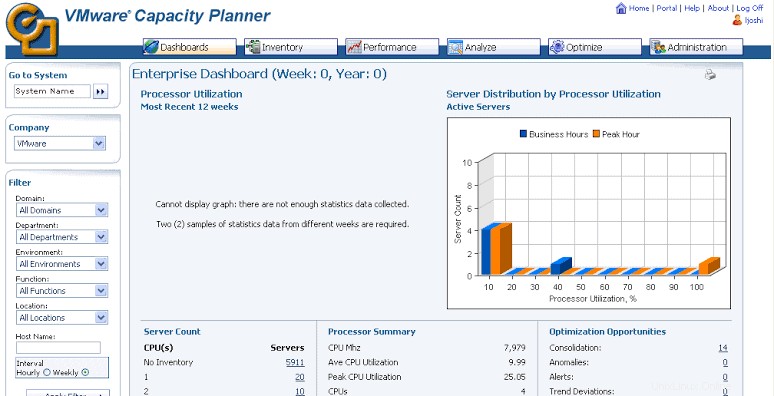
Features of VMware Capacity Planner
- Virtual machine administrators can use this software to view the CPU utilization of their data center servers very easily.
- VMware Capacity Planner allows admins to study the Processors, RAM, Network bandwidth, and Disk usage across multiple virtual servers.
- It can be used for increasing enterprise productivity with server consolidation and optimization.
- The capacity utilization trends and virtualization benchmarks provide by this tool can help improve predictability.
21. VMware Health Analyzer
VMware Health Analyzer(vHA) is one of the most useful VMware tools for optimization purposes. It can be used for inspecting your virtual machine environments effortlessly and increasing productivity. The tool employs a variety of standard practices to determine your virtual machines’ health and reduces system downtimes by a considerable margin. If you’re a professional VMware engineer working in enterprise-grade products, you may want to check this software.
Features of VMware Health Analyzer
- VMware Health Analyzer provides consistent data collection abilities for large-scale enterprises.
- Admins can easily export the collected data to files or may opt in to import them inside existing projects.
- VMware Health Analyzer allows administrators to create reports on their virtual machine’s health using MS Word tools.
- It has in-built support for networking and can use several ports for making SSH, HTTP, and HTTPS requests.
22. VMware OS Optimization Tool
Optimization of guest operating systems is essential for the performance of your virtual machine infrastructure. The VMware OS Optimization Tool is one of the best VMware tools for this purpose.
It can be used to optimize various Windows OS such as Windows 7 and 10. It offers some advantageous features in this regard. So, If you’re deploying your products inside a Windows virtual machine, consider checking out the VMware OS Optimization Tool.
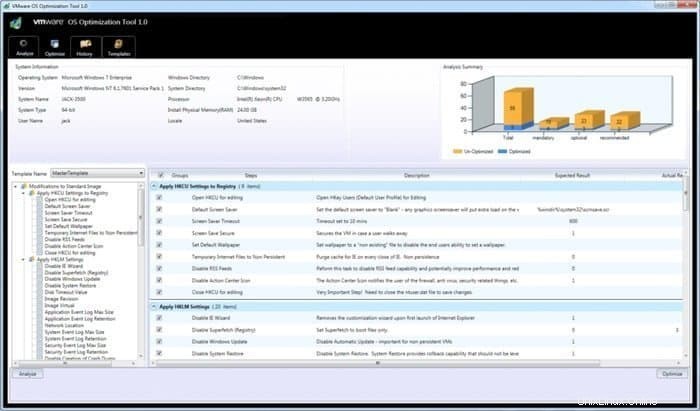
Features of VMware OS Optimization Tool
- VMware OS Optimization Tool allows admins to effectively manage the templates, optimize the history and rollbacks of their virtual machines.
- You can use this VMware administrator tool for optimizing both local and remote virtual machines.
- It is often used for disabling Windows services that take too many resources of the host system.
23. VMware Project Onyx
The VMware Project Onyx is a robust utility that allows admins to generate codes based on simple mouse clicks in the vSphere client. It is aimed at making visualization easier for busy developers and does a great job.
This standalone application acts as a proxy between the vSphere Client and the Server software running on different locations. It is the perfect tool for experienced developers working on enterprise-level visualization projects.
Features of VMware Project Onyx
- VMware Project Onyx monitors the network communication between the vSphere Client and the vCenter Server for generating the code samples.
- It creates PowerShell code snippets based on the afore-mentioned communication.
- Onyx allows admins to modify or save this code for use inside another project file.
- It can be used for building automated intelligent solutions for your VMware infrastructure.
24. VMware Skyline
VMware Skyline is a support software to enhance the productivity of teams that manage highly complex virtualization environments. It helps users in avoiding many potential problems by increasing the overall efficiency of their VMware environments.
It ships natively with your VMware Production support or the Premier Services plan. If you’re building or maintaining large-scale infrastructure, VMware Skyline is a must-have tool for you.
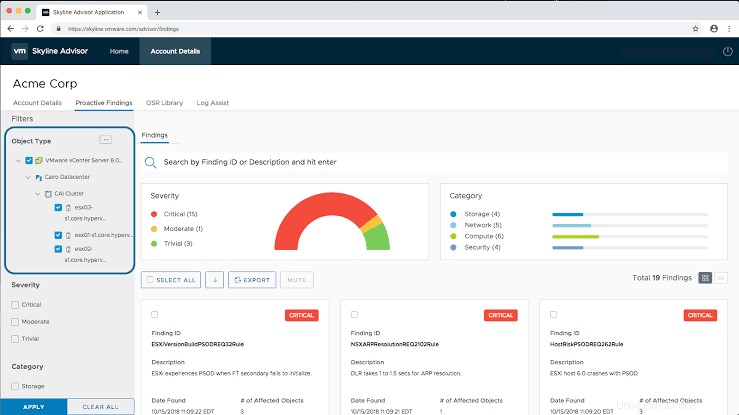
Features of VMware Skyline
- VMware Skyline consolidates the SW compatibility regular checks across services like vSphere, vSAN, NSX-v, vROps, and Horizon.
- The in-built integration of Dell EMC SupportAssist makes VMware Skyline the best of its kind.
- The Skyline Log Assist feature of this VMware administrator tool can automatically upload log bundles to VMware Tech Support.
25. VMware vRealize Orchestrator
vRealize Orchestrator is one of the most beneficial VMware tools for enterprises due to its rich feature set and diverse usage. It is a compelling administration tool that allows admins to create automated workflows to tackle day-to-day tasks conveniently. It provides a friendly GUI interface that offers drag-and-drop support. Overall, it is a beneficial solution for IT managers in charge of operational management and IT agility.
Features of VMware vRealize Orchestrator
- It becomes straightforward to design and deploy scalable automation workflows to handle complex IT processes using this tool.
- This VMware tool’s open and flexible architecture allows admins to properly handle service desks, change management, and asset management.
- VMware vRealize Orchestrator makes management more insightful by offering many plug-ins based on PowerShell scripts and robust Web APIs.
26. WinSSHterm
WinSSHterm is a compelling ssh client for guest systems running Windows and combines a tabbed solution with many useful tools like the WinSCP, VcXsrv, and PuTTY. It can be used for remote login into virtual machine clusters and operate on them effectively.
Thes software is really lightweight and offers consistent performance metrics. So, don’t forget to check out WinSSHterm if you’re IT personnel working with enterprise-level virtualization products.

Features of WinSSHterm
- It is ready for use in production environments and works efficiently with PuTTY executables.
- The command-line interface of this SSH client supports multiple tabs, windows and offers eyesight-friendly terminal colors.
- WinSSHterm allows admins to share their connections with colleagues or team partners.
- You can download the portable version, which can be easily migrated from tools like PuTTY and mRemoteNG.
27. Kubewise
Kubewise is a simple yet accommodating VMware client for Kubernetes. It is a lightweight tool that only requires a valid kubeconfig file for executing commands against a Kubernetes cluster.
Kubernetes has become the de-facto container-orchestration system for automating application deployment; Kubewise can be the perfect solution for doing this from your VMware virtual machines. Although Kubewise is not directly associated with the Cloud Native Computing Foundation (CNCF), it does its job pretty well.
Features of Kubewise
- Kubewise comes with in-built support for multiple kubeconfig files and highlights security-related data.
- It allows users to set proper KUBECONFIG env variables with only a single click in the terminal.
- Kubewise can also generate personalized kubeconfig files for a given namespace.
- The UI-driven interaction with frequently used Kubernetes entities allows admins greater control.
28. vSphere Mobile Client
The vSphere Mobile Client software allows virtualization engineers to monitor and manage vSphere infrastructures directly from their mobile devices. It is a modern-day solution to increase productivity by enabling the system manager to be connected with their vSphere server 24/7. It is one of the few VMware tools that allow admin to control their workstations from their smartphones.
Features of vSphere Mobile Client
- It allows admins to review their virtual machine’s status, including state, resource consumption, and configuration information.
- Admins can easily change the power state of their virtual machines using this mobile application.
- The concise performance charts presented by vSphere Mobile Client allow admins to monitor their environments in real-time.
- The software is available only for the Android platform as of this writing.
29. vSAN Performance Monitor
The vSAN Performance Monitor is one of the best VMware tools for monitoring your virtual network storage’s performance metrics. It is a highly useful tool that has several use cases for modern virtualization providers. Once you install and configure this software, it will automatically collect various vSAN performance metrics and provide valuable information.
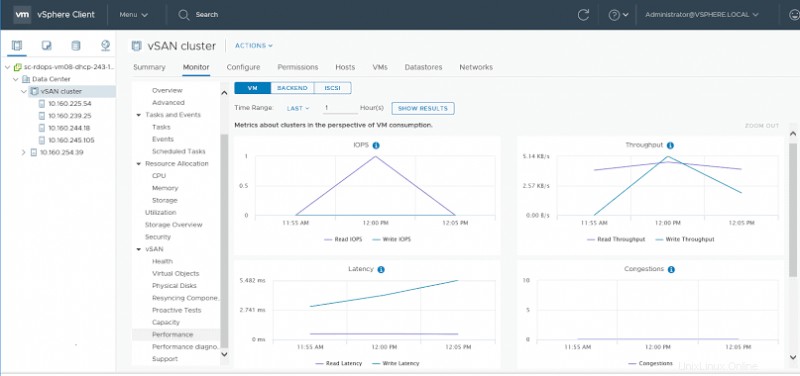
Features of vSAN Performance Monitor
- The vSAN Performance Monitor tool has three fundamental components, a Telegraf collector, InfluxDB, and a Grafana frontend.
- The Telegraf collector is the agent responsible for collecting performance metrics from the vSAN cluster.
- The information is stored inside InfluxDB, and Grafana allows admins to visualize this information.
30. MyVMware CLI
MyVMware CLI is a lightweight yet handy command-line tool that can be used for log into and manage my.vmware.com. It is an excellent utility for managing your VMware workstations from the browser and allows some robust functionalities. Download this tool to check how to leverage this for your virtualization projects.
Features of MyVMware CLI
- MyVMware CLI allows admins to find each of their products, files, and other version information.
- It offers a convenient interface that allows programmatic query and download of VMware product executables.
- The software is open source and thus can be modified without any permission.
Ending Thoughts
Our editors have gone through a massive list of VMware tools for preparing this guide for you. Hopefully, we have provided you the essentials you were looking for from this guide. We’ve highlighted several widely use VMware management tools alongside other productive VMtools. Follow the download links given below each application to install it in your VMware machine. Stay with us for more exciting guides on Linux virtual machines and cloud computing resources.